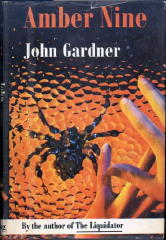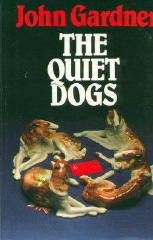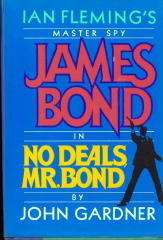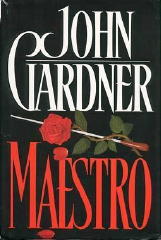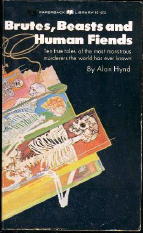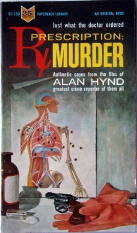Search Results for 'capone'
Did you find what you wanted ?
Thu 23 Aug 2007
Best-selling spy novelist John Gardner passed away on 3 August 2007.
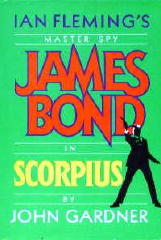
Best-known as the most prolific of the writers contracted to continue the adventures of James Bond after the death of Ian Fleming, Gardner, a former Anglican clergyman and recovering alcoholic, would eventually write 16 Bond novels, more than Fleming wrote himself, between 1981 and 1996.
Ironically, Gardner broke into spy fiction with a series about Boysie Oakes, a cowardly, selfish, and not particularly patriotic character who’s dragooned into spy work pretty much against his will. Oakes was created to be more or less the antithesis of Bond, yet the Oakes novels were an integral part of the resume that got Gardner the Bond gig.
Though his Bond novels are probably his best-known and most popular work, his reputation as a top-flight cloak-and-dagger writer would be secure if he’d never written a single word about 007. Two series in particular stand as his best work in the sub-genre.
His five novels featuring Herbie Kruger, a naturalized Brit of German birth who, after emigrating, has become the top agent of MI-6, are among the best series of British spy novels in the post-Le Carre era. Kruger debuted in The Nostradamus Traitor. The penultimate novel in the Kruger series, Maestro, was reportedly Gardner’s personal favorite of all his books.
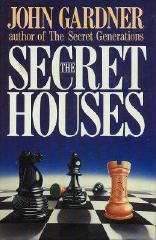
Kruger also makes a few cameo appearances in Gardner’s “Secret” trilogy, featuring the British Railtons and the American Farthings, two families, related by marriage, who defend freedom by choosing careers in their respective countries’ intelligence services. The trilogy effectively combined the multi-generational family saga, historical fiction, and espionage in an ambitious project that attempted, largely successfully, to show the history of espionage from just before World War I to the early 60s. The three books in the trilogy are The Secret Generations, The Secret Houses, and The Secret Families.
Most identified with spy fiction, Gardner was a versatile writer who could easily slip into other mystery sub-genres. A pair of carefully researched novels set in the world of Sherlock Holmes, for example, were told from the point of view of Professor Moriarty, depicting the iconic villain less as the effete “criminal mastermind” Conan Doyle portrayed than as a Victorian version of Al Capone or Don Corleone. Originally planned as a trilogy, the third novel has never appeared.
Two police procedurals, A Complete State of Death and The Corner Men, featured Scotland Yard detective Roger Torrey. The first, with the setting changed from London to New York, became the Charles Bronson film The Stone Killer.
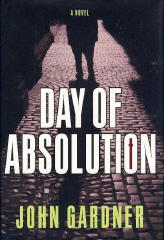
Between 1995 and 2001, Gardner abruptly stopped writing while he simultaneously fought cancer and the grief caused by his wife’s death. Winning his battle with the disease and coming to terms with the death of his spouse, he returned to writing with a vengeance, turning out a top-notch international thriller, Day of Absolution, and starting a new historical police procedural series about Suzie Mountford, a London Metropolitan policewoman fighting crime, and sexism,in the early years of World War II. The latest Mountford novel, No Human Enemy, will appear in bookstores later this month. Reportedly, the long-awaited third novel in the Moriarty trilogy is also being readied for publication.
He’ll be missed.
THE BOOKS. Adapted from Crime Fiction IV, by Allen J. Hubin.
GARDNER, JOHN (Edmund) (1926-2007 ) British editions only, unless US titles differ.
* The Liquidator (n.) Muller 1964 [Boysie Oakes]
* Understrike (n.) Muller 1965 [Boysie Oakes]
* Amber Nine (n.) Muller 1966 [Boysie Oakes]
* Madrigal (n.) Muller 1967 [Boysie Oakes]
* Hideaway. Corgi 1968. Story collection.
* A Complete State of Death (n.) Cape 1969 [Derek Torry]
* Founder Member (n.) Muller 1969 [Boysie Oakes]
* The Airline Pirates (n.) Hodder 1970 [Boysie Oakes]
* -The Censor (n.) NEL 1970
* Traitor’s Exit (n.) Muller 1970 [Boysie Oakes]
* Air Apparent (n.) Putnam 1971; See: The Airline Pirates (Hodder 1970).
* The Stone Killer (n.) Award 1973; See: A Complete State of Death (Cape 1969).
* The Assassination File (co) Corgi 1974
* The Corner Men (n.) Joseph 1974 [Derek Torry]
* The Return of Moriarty (n.) Weidenfeld 1974 [Prof. James Moriarty]
* A Killer for a Song (n.) Hodder 1975 [Boysie Oakes]
* The Revenge of Moriarty (n.) Weidenfeld 1975 [Prof. James Moriarty]
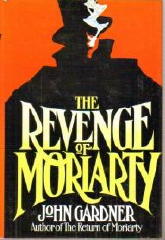
* To Run a Little Faster (n.) Joseph 1976
* The Werewolf Trace (n.) Hodder 1977
* The Dancing Dodo (n.) Hodder 1978
* The Nostradamus Traitor (n.) Hodder 1979 [Herbie Kruger]
* The Garden of Weapons (n.) Hodder 1980 [Herbie Kruger]
* Golgotha (n.) Allen 1980 [England; 1990]
* The Last Trump (n.) McGraw 1980; See: Golgotha (Allen 1980).
* License Renewed (n.) Cape 1981 [James Bond]
* For Special Services (n.) Cape 1982 [James Bond]
* The Quiet Dogs (n.) Hodder 1982 [Herbie Kruger]
* Flamingo (n.) Hodder 1983
* Icebreaker (n.) Cape 1983 [James Bond]
* Role of Honour (n.) Cape 1984 [James Bond]
* The Secret Generations (n.) Heinemann 1985 [Railton family; Farthing family]
* Nobody Lives Forever (n.) Cape 1986 [James Bond]
* No Deals, Mr. Bond (n.) Cape 1987 [James Bond]
* Scorpius (n.) Hodder 1988 [James Bond]
* The Secret Houses (n.) Bantam 1988 [Railton family; Farthing family; Herbie Kruger]
* License to Kill (n.) Coronet 1989 [James Bond]
* The Secret Families (n.) Bantam 1989 [Railton family; Farthing family; Herbie Kruger]
* Win, Lose or Die (n.) Hodder 1989 [James Bond]
* Brokenclaw (n.) Hodder 1990 [James Bond]
* The Man from Barbarossa (n.) Hodder 1991 [James Bond]
* Death Is Forever (n.) Hodder 1992 [James Bond]
* Maestro (n.) Bantam 1993 [Herbie Kruger]
* Never Send Flowers (n.) Hodder 1993 [James Bond]
* Seafire (n.) Hodder 1994 [James Bond]
* Confessor (n.) Bantam-UK 1995 [Herbie Kruger]
* Goldeneye (n.) Coronet 1995 [James Bond]
* Cold Fall (n.) Hodder 1996 [James Bond]
* Day of Absolution (n.) Scribner-US 2000
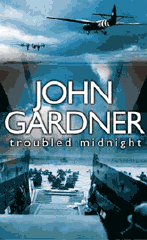
Detective Sergeant Suzie Mountford novels —
* Bottled Spider (2002)
* The Streets of Town (2003)
* Angels Dining at the Ritz (2004)
* Troubled Midnight (2005)
* No Human Enemy (2007)
For more on John Gardner’s life, as he told it himself, go to
http://www.john-gardner.com/past.html
Mon 16 Jul 2007
PAULA GOSLING – Death and Shadows
Warner, British paperback; 1st printing, 2000. British hardcover edition: Little, Brown; 1998. No US edition.
A brief bit of biographical information first, if you’ll allow me, because an explanation’s going to be needed as to why a book taking place in Michigan’s Upper Peninsula has been published in the UK but never here in the US. According to one website, Paula Gosling was born in Detroit in 1939, but she moved permanently to England in 1964. After working as a copywriter and a copy consultant she became a full-time writer in 1979.
Taken from both that website and Crime Fiction IV, by Allen J. Hubin, here’s a complete list of her book-length mystery fiction, as published in the UK. Most of these are also available in paperback editions, but I haven’t taken the time to investigate into these. The last four, though – the ones marked # – have never had a US edition:
• A Running Duck (n.) Macmillan 1978 [San Francisco, CA]
= Fair Game (n.) Coward 1978. Revised and expanded from:
A Running Duck.
• The Zero Trap (n.) Macmillan 1979 [Arctic]
• Loser’s Blues (n.) Macmillan 1980 [London]
= Solo Blues (n.) Coward 1981. See:
Loser’s Blues.
• The Woman in Red (n.) Macmillan 1983 [Spain]
• Monkey Puzzle (n.) Macmillan 1985 [Lt. Jack Stryker; Ohio; Academia]
• The Wychford Murder (n.) Macmillan 1986 [Luke Abbott; England]
= The Wychford Murders (n.) Doubleday 1986. See:
The Wychford Murder.
• Hoodwink (n.) Macmillan 1988 [Lt. Jack Stryker (only briefly); Ohio]
• Backlash (n.) Macmillan 1989 [Lt. Jack Stryker; Michigan]
• Death Penalties (n.) Scribner 1991 [Luke Abbott; London]
• The Body in Blackwater Bay (n.) Little 1992 [Lt. Jack Stryker; Matt Gabriel; Michigan]
• A Few Dying Words (n.) Little 1993 [Matt Gabriel; Michigan]
• The Dead of Winter (n.) Little 1995 [Matt Gabriel; Michigan]
• Death and Shadows (n.) Little 1999 [see below; Michigan] #
• Underneath Every Stone (n.) Little 2000 [Matt Gabriel; Michigan] #
• Ricochet (n.) Little 2002 [Lt. Jack Stryker; Michigan] #
• Tears of the Dragon (n.) Allison & Busby 2004 [Chicago, 1931; the era of Al Capone] #
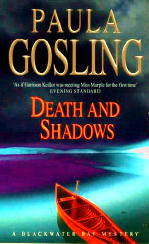
I’ve already informed Al that he omitted Matt Gabriel as a series character in Death and Shadows. Gabriel is the sheriff for Blackwater Bay, a sleepy backwater resort town that over the years has have more than its share of unusual mysteries to solve. Jack Stryker, who’s a lieutenant for the police force a few towns over, makes a cameo appearance in Death and Shadows – never in person, only by telephone.
Here’s a question for you. How are hospitals and serial killers alike? Answer: I don’t usually read mysteries in which either one is involved, and here I violated my own rules twice, as that’s exactly what kind of mystery this is – one in which the staff and patients in a private nursing home are found murdered, one by one.
As I pointed out earlier, Matt Gabriel is the local sheriff, but as it turns out, he’s neither of the two primary leading characters, the first being physiotherapist Laura Brandon. She’s the niece of the owner of Mountview Clinic, and extremely interested in learning how her friend and predecessor for the position was murdered. The second of the ad hoc sleuthing pair that gradually develops is Tom Gilliam, a patient who’s withdrawn well into himself since the mishap iy was that forced him off Jack Stryker’s police force.
Another reason why I surprised myself in reading this book is that it is nearly 380 pages long, and in small print too. A hospital setting, a possible psychotic killer on the loose, and a book twice as long as my usual reading fare. You’d think it would be a matter of three strikes and out, but not so. This book kept me up reading for several nights in a row. I was able to put it down, but the next evening I couldn’t resist, and I was back reading it again.
Maybe because the opening two or three chapters read exactly like a gothic novel, with a young(ish) girl coming fresh into a new mysterious and slightly spooky setting. A manor house, a hospital – it makes little difference. Maybe because in 380 pages there is an ultra-abundance of clues to be puzzled over, with lots of secrets on the part of almost everybody, broken hand railings, a local legend called the Shadowman. Maybe because of the many, many red herrings and false trails to follow and double back upon. Delicious!
Fri 13 Jul 2007
Hi Steve,
Please find below a brief biography (well, the only one I have found) on the writer who, as Armitage Trail, wrote the novel Scarface.
I wonder if anyone has ever done any research to track down the pseudonymous work mentioned in it. I asked Victor Berch who knows little more — apparently he could not even find him in the census for the years he was alive. (Apparently his brother, also difficult to trace in official records, wrote over 20 episodes for the Addams Family [television show] amongst other work).
Just wonder if he is worth putting in your blog to see if anyone can add to the bio?
Armitage Trail was a pseudonym for the American author Maurice Coons. The son of a theatrical impresario who managed the road tours of the New Orleans Opera Company, and also manufactured furniture and farm silos, Maurice Coons left school at 16 to devote all his time to writing stories. By 17 or 18, he was already selling stories to magazines. By his early twenties he was writing whole issues of various detective-story magazines under a great assortment of various names. And at 28 — after going to New York to write more stories, and from there to Hollywood to write movies — he dropped dead of a heart attack at the downtown Paramount Theatre in Los Angeles.
At the time of his death, he weighed 315 pounds, had a flowing brown moustache, and wore Barrymore-brim Borsalina hats. He was survived by his brother, humorous writer Hannibal Coons.
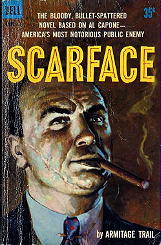
Maurice Coons gathered the elements for Scarface when living in Chicago, where he became acquainted with many local Sicilian gangs. For a couple of years, Coons spent most of his nights prowling Chicago’s gangland with his friend, a lawyer, and spent his days sitting in the sun room of his Oak Park apartment writing Scarface. He never did meet Al Capone, who was the inspiration for his immortal character, though Capone was very much alive when his book was published.
When Howard Hughes was making plans to produce the movie, Coons wanted Edward G. Robinson to play the leading role because of his resemblance to Capone but being Hollywood, it ended up with Paul [Muni] playing Scarface, a different-looking sort of man altogether. The author did not live to see the picture, but Al Capone did, and screenwriter Ben Hecht had to talk fast to convince his henchmen that Scarface was not based on him. Scarface was also made into a film in 1983, directed by Brian de Palma and starring AI Pacino. Armitage Trail’s only other surviving novel is The Thirteenth Guest ( 1929). Both his novels prefigure the birth of hard-boiled fiction and Black Mask magazine.
From Crime Fiction IV, by Allen J. Hubin:
COONS, MAURICE (1902-1930); see pseudonym Armitage Trail.
TRAIL, ARMITAGE; pseudonym of Maurice Coons.
* * Scarface (Clode, 1930, hc) [Chicago, IL] Long, 1931. Film: United Artists, 1932 (scw: Fred Palsey, W. R. Burnett, John Lee Mahin, Seton I. Miller, Ben Hecht; dir: Howard Hawks). Also: Universal, 1983 (scw: Oliver Stone; dir: Brian De Palma).
* * The Thirteenth Guest (Whitman, 1929, hc) Film: Monogram, 1932 (scw: Francis Hyland, Arthur Hoerl, Armitage Trail; dir: Albert Ray). Also: Monogram, 1943, as Mystery of the Thirteenth Guest (scw: Charles Marlon, Tim Ryan, Arthur Hoerl; dir: William Beaudine).
Sat 10 Feb 2007
The following email inquiry came from David Karschner:
Enjoy reading your blog, thanks! Have a question you can hopefully help with concerning Alan Hynd and the supposedly true stories he wrote for
True Detective Mysteries etc. Am doing research on a distant relative named William Watts who worked as an engraver in the Count Lustig counterfeiting ring circa 1930-1935. Hynd authored a six part series in
TDM in 1937 about Lustig and Watts. While the major facts jibe with historical data the personal story regarding the two outlaws seems quite fanciful. How much truth can one rely on coming from these types of stories? Believe it or not two of the
TDM episodes were found in Watts’ Secret Service file.
Also do you have any idea on a method for contacting his son Noel Hynd?
Any input would be appreciated.
Thanks, David
If anything, true crime is a category about which I can safely say that I know less than nothing, if it could be possible, so anyone who knows more than I do, or have been able to uncover so far, please chuck a life preserver my way. I’m in over my head, in other words.
But checking with Allen Hubin’s Crime Fiction IV, emphasis on the “fiction,” I was mildly surprised to discover that there is an entry there for Alan Hynd:
HYND, ALAN (1903-1974)
* * Alan Hynd’s Murder (Duell, 1952, hc) Collection. Somewhat dramatized true crime.
* * Brutes, Beasts and Human Fiends (Paperback Library, 1964, pb) Collection. Dramatized true crime.
* * The Case of the Lady Who Took a Bath (Berkley, 1957, pb) Collection. Dramatized true crime.
* * Great Crime Busters (Putnam, 1967, hc) Collection. Dramatized true crime, intended for younger readers.
* * Great True Detective Mysteries (Grosset, 1968, hc) Collection. Dramatized true crime.
* * In Pursuit: The Cases of William J. Burns (New York: Nelson, 1968, hc) [Series Character] William J. Burns] Collection. Dramatized true crime.
* * Murder! Great True Crime Cases (Penguin, 1947, pb) Collection. Dramatized true crime.
* * The Pinkerton Case Book (Signet, 1948, pb) Collection. Dramatized true crime.
* * Prescription: Murder (Paperback Library, 1962, pb) Collection. Dramatized true crime.
* * ’Til Death Do Us Part (Paperback Library, 1962, pb) Collection. Dramatized true crime.
* * Violence in the Night (Gold Medal, 1955, pb) Collection. Somewhat dramatized true crime.
Perhaps the question asks itself. Does “dramatized” equate to “fictionalized?” I haven’t asked Al yet what his standards or definitions are in this somewhat borderline category, but when I do, I’ll add his reply as an update.
Dave’s reply:
Dramatized is the correct word, thanks. My problem is separating fact from fiction. For example: As Hynd writes in his articles of an important connection between Al Capone,Count Lustig and my relative William Watts I just wonder what his sources for information were? I am hoping since some of Alan Hynd’s articles were in Watts’ Secret Service files (ones I uncovered thru the FOIA) that he had some great contacts. Who knows?
As for Noel Hynd, whom (since I never thought about it) I never realized until now is Alan Hynd’s son, he has an entry in CFIV as well. These I’ll put in chronological order:
HYND, NOEL (1947- ); Born in New York City, the son of Alan Hynd, 1908-1974, q.v.; raised in Connecticut, educated at University of Pennsylvania; crime reporter.
# Revenge. Dial 1976
# The Sandler Inquiry. Dial 1977
# False Flags. Dial 1979
# Flowers from Berlin. Dial 1985
# The Krushchev Objective [with Christopher Creighton]. Doubleday 1987
# Truman’s Spy. Zebra 1990
# Zigzag. Zebra 1992
# -Ghosts. Zebra 1993
# A Room for the Dead. Kensington 1994
# Cemetery of Angels. Kensington 1995
# Rage of Spirits. Kensington 1997
# The Lost Boy. Pinnacle 1999
Doing some quick Googling, this list does not include, within the proper time frame of 2000 and before, The Prodigy (1997), which appears to be a supernatural horror story only.
There are some interviews with Noel Hynd which you can easily find online, but they all seem to taken place in the late 1990s. A rather complete biography can be found at IMDB, and this led me to his most recent book, The Enemy Within, which was published by Tor/Forge in 2006. [But with nothing published between 1999 and 2006.]
Dave is now attempting to reach Mr. Hynd through Forge.
—
UPDATE [02-11-07] I’ve just heard from Al Hubin, who says:
Steve,
By “dramatized” and “fictionalized” I generally mean to imply that material was added (usually dialogue) to enhance the story, which is based on true events. The degree of “dramatization” and “fictionalization” may vary widely, and the Revised CFIV will include a good deal more of Alan Hynd’s work. (I bought copies of a number of his books in order to see what sort of thing he wrote and to be able to list the story titles.)
All very imprecise, I’m afraid!
Best,
Al



